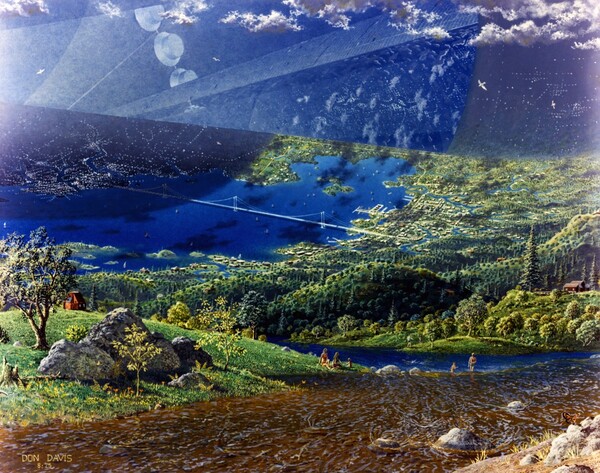This article explores: Life inside an O’Neill Cylinder: Social and psychological implications for space settlers. Find out more about O’Neill Cylinder Social and psychological implications.

As humanity looks towards the future of space exploration and the possibility of long-term colonization beyond Earth, the concept of an O’Neill Cylinder has gained significant attention.
With its potential to sustain human life within a self-sustaining space colony, an O’Neill Cylinder could provide a new frontier for human settlement. However, with this new environment comes unique challenges and potential psychological effects that must be considered.
In this article, we will explore the social and psychological implications of living inside an O’Neill Cylinder, including the potential challenges of social isolation, restricted movement, and the impact of artificial lighting on mental health.
We will also examine the potential benefits of living in a self-sustaining space colony, including the sense of community and shared purpose that could emerge.
How Many People Could Actually Live In An O’Neill Cylinder?
The capacity of an O’Neill Cylinder depends on its size, design, and the level of resources it can support. The original O’Neill design proposed a cylinder that is 32 kilometers long and 5 kilometers in diameter, which could potentially house millions of people.
However, some proposed designs for O’Neill Cylinders are much smaller, with a length of around 1 kilometer and a diameter of 500 meters, which could support a population of around 10,000 people.
The actual number of people that could live in an O’Neill Cylinder would depend on factors such as the availability of resources like food, water, and oxygen, as well as the level of self-sufficiency of the colony.
A self-sufficient O’Neill Cylinder would be able to support a larger population, while a colony that relies heavily on supplies from Earth would be limited by the availability of resources.
What Would Life Be Like In An O’Neill Cylinder?
Life in an O’Neill Cylinder would be similar in many ways to life on Earth, but with some significant differences due to the unique environment and design of the cylinder.
Here are some aspects of life in an O’Neill Cylinder:
Gravity:
One of the most significant differences between life in an O’Neill Cylinder and life on Earth is the gravity. An O’Neill Cylinder would generate artificial gravity by spinning around its central axis, which would create a sensation of gravity similar to that on Earth. However, this gravity would be much weaker than Earth’s, and people would need to adapt to this new environment.
Environment:
The O’Neill Cylinder would provide a self-sustaining environment, with air, water, and food all produced within the cylinder. The environment would be carefully controlled to maintain a comfortable temperature, humidity, and air pressure for human habitation.
Living Spaces:
Living spaces in an O’Neill Cylinder would be similar to apartments or houses on Earth, with private bedrooms, bathrooms, and shared living spaces like kitchens and living rooms. However, these spaces would be more compact to optimize living space, and the design would be optimized to reduce energy use.
Work:
People living in an O’Neill Cylinder would have jobs similar to those on Earth, such as agriculture, manufacturing, research, and administration. Workspaces would be designed to optimize productivity and energy efficiency.
Community:
An O’Neill Cylinder would be a self-contained community, with people from various backgrounds and cultures living together. There would be opportunities for socializing, recreation, and education within the cylinder.
Overall, life in an O’Neill Cylinder would be similar to life on Earth in many ways, but with adaptations needed to adjust to the unique environment and design of the cylinder. The focus would be on creating a sustainable, self-sufficient community that can thrive in space for generations to come.
How Would O’Neill Cylinder Society Be Managed?
The management of an O’Neill Cylinder society would be a complex task, requiring careful planning and organization to ensure the smooth functioning of the community.
O’Neill Cylinder society management would require a collaborative and holistic approach, with a focus on sustainability, self-sufficiency, and community involvement.
The success of the community would depend on the effectiveness of its management and the commitment of its members to working together for the common good.
Here are some aspects of how an O’Neill Cylinder society might be managed:
Governance:
An O’Neill Cylinder would likely have some form of government or governing body, with leaders elected or appointed to make decisions and enforce rules. The exact form of governance would depend on the values and priorities of the community, as well as the size of the population.
Planning and Development:
The management of an O’Neill Cylinder society would involve careful planning and development of resources to ensure sustainability and self-sufficiency. This would include planning for food, water, energy, and waste management, as well as the development of infrastructure like housing, transportation, and healthcare facilities.
Education and Training:
Education and training would be critical components of an O’Neill Cylinder society, to ensure that people have the skills and knowledge needed to maintain the community and contribute to its development. Education and training programs could cover a range of subjects, from science and technology to agriculture and healthcare.
Social Services:
An O’Neill Cylinder society would need to provide social services like healthcare, childcare, and elder care to ensure the well-being of its members. Social services could be provided through a combination of public and private organizations, with funding from the government or community members.
Community Involvement:
The management of an O’Neill Cylinder society would involve a high degree of community involvement, with members participating in decision-making processes and contributing to the development and maintenance of the community. This could include community events, volunteer work, and other activities that promote a sense of belonging and shared responsibility.
What Would People Do For A Living On An O’Neill Cylinder?
People on an O’Neill Cylinder would need to work in a variety of jobs to sustain the community and ensure its self-sufficiency.
Here are some potential job areas that could exist on an O’Neill Cylinder:
Agriculture:
With limited space and resources, agriculture would be a critical component of an O’Neill Cylinder. People could work as farmers, gardeners, or agricultural scientists to ensure the production of food for the community.
Manufacturing:
Manufacturing could play a key role in the O’Neill Cylinder economy, with people working in factories or workshops to produce goods and materials needed for the community. This could include everything from clothing and consumer goods to machinery and construction materials.
Science and Technology:
The O’Neill Cylinder would be a hub of scientific and technological innovation, with people working in fields like physics, engineering, and biology to develop new technologies and solve complex problems.
Healthcare:
Healthcare would be essential on an O’Neill Cylinder, with people working as doctors, nurses, and other healthcare professionals to ensure the well-being of the community.
Education:
Education would also be critical on an O’Neill Cylinder, with people working as teachers, professors, or educational administrators to provide educational opportunities for the community.
Service Industry:
People could work in the service industry, providing services such as hospitality, entertainment, or retail to other community members.
Administration:
Administration would be essential for the effective management of the O’Neill Cylinder, with people working in roles such as finance, law, or management to ensure the smooth functioning of the community.
These are just a few examples of the potential job areas that could exist on an O’Neill Cylinder. The specific job market would depend on the needs and priorities of the community, as well as the skills and expertise of its members.
What Are The Psychological Effects Of Living In An O’Neill Cylinder?
Living in an O’Neill Cylinder would be a unique experience with its own set of psychological challenges. Here are some potential psychological effects that could arise from living in an O’Neill Cylinder:
Social isolation:
Living in a closed environment with a limited number of people could lead to feelings of social isolation and loneliness, particularly if there are few opportunities to meet new people or form new relationships.
Lack of privacy:
With limited living space, privacy could be difficult to come by on an O’Neill Cylinder, which could lead to feelings of discomfort or anxiety.
Homesickness:
Living in a completely artificial environment with no direct contact with the outside world could lead to feelings of homesickness and a longing for natural environments.
Restricted movement:
An O’Neill Cylinder is a closed environment with limited space, which could lead to feelings of confinement or restlessness over time.
Adjusting to artificial light:
The O’Neill Cylinder would likely rely on artificial light to simulate daylight and nighttime, which could have an impact on the body’s natural sleep-wake cycle and potentially lead to sleep disturbances.
Psychological stressors:
Living in a self-contained environment with limited resources could create psychological stressors, such as concerns about sustainability or worries about the potential failure of essential systems.
These are just a few examples of the potential psychological effects of living in an O’Neill Cylinder. However, it’s important to note that there are also potential benefits to living in a self-sustaining space colony, such as a sense of community and a shared mission to sustain human life beyond Earth.
References for: “Life inside an O’Neill Cylinder: Social and psychological implications for space settlers”
“The High Frontier: Human Colonies in Space” by Gerard K. O’Neill – This classic book discusses the social and psychological implications of living inside an O’Neill cylinder, including issues such as community building and isolation.
“Living Aloft: Human Requirements for Extended Spaceflight” by NASA – This report examines the psychological and social challenges of long-term spaceflight, including the implications for space settlers living inside O’Neill cylinders.
“Space Settlements: A Design Study” by NASA – This study, conducted in the 1970s, explores the social and psychological aspects of space colonization, including life inside O’Neill cylinders.
“The Sociology of Space: Materiality, Social Structures, and Action” edited by Martina Löw and Silke Steets – This book includes a chapter on the social and psychological implications of living inside an O’Neill cylinder.
“Space Settlement Basics” by Al Globus, Bryan Versteeg, and Grant Bonin – This book examines the social and psychological challenges of space colonization, including life inside O’Neill cylinders.
“The Millennial Project: Colonizing the Galaxy in Eight Easy Steps” by Marshall T. Savage – This book discusses the social and psychological aspects of space colonization, including life inside O’Neill cylinders.
“Space Architecture: The New Frontier for Design Research” edited by Neil Leach – This book includes a chapter on the social and psychological implications of living inside an O’Neill cylinder, including the importance of creating community and social structures.
“Psychological and Social Issues of Long-Duration Space Missions: Review and Research Recommendations” by the National Research Council – This report examines the social and psychological challenges of long-duration space missions, including those associated with life inside O’Neill cylinders.
“Space Manufacturing 3: Proceedings of the Fourth Princeton/AIAA Conference” edited by John H. Hoffman and Frederick A. Candelaria – This conference proceedings book includes papers on the social and psychological challenges of space colonization, including those associated with life inside O’Neill cylinders.
“Space Politics and Policy: An Evolutionary Perspective” by J.R. Sadeh – This book includes a chapter on the social and psychological implications of space colonization, including life inside O’Neill cylinders.
‘Life inside an O’Neill Cylinder: Social and psychological implications for space settlers’ is one important topic in our series exploring the role of O’Neill Cylinders in space colonization.
Read more about these topics by following the links below:
Republished by Blog Post Promoter
